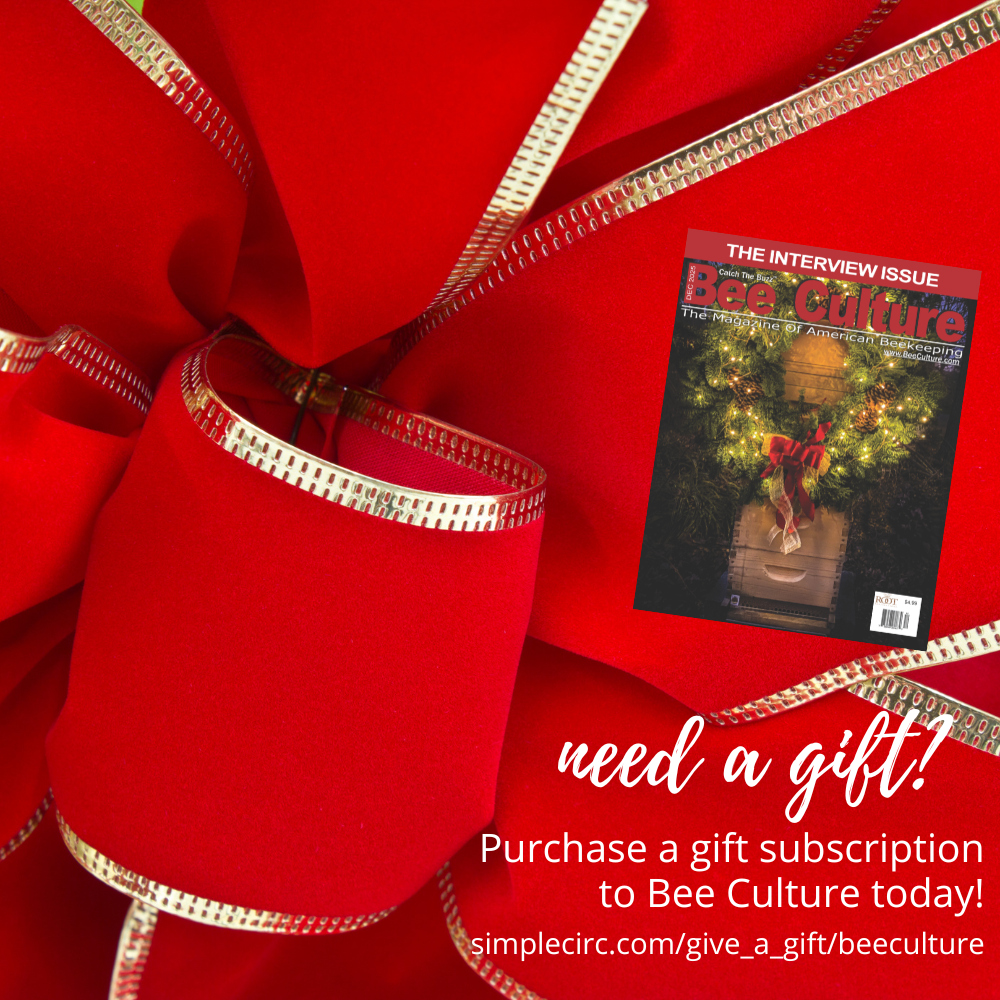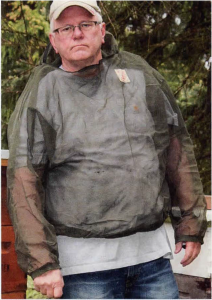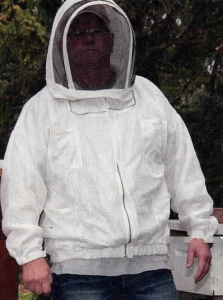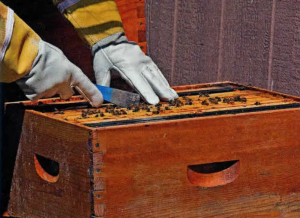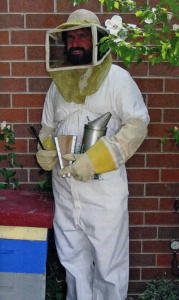By: James E. Tew
This article originally appeared in the Autumn 2016 issue of BEEKeeping Your First Three Years
Go to task with proper gear.
I grew up in a hot climate, but I will spare you the memory walk. Upon taking up beekeeping, my primary concern was to avoid all stings. Not just to avoid a few stings, but to avoid all stings. To that end, I dressed myself in the typical designer beekeeper ensemble: A full-length white bee suit, a securely tied veil, gloves up to my neck, special boot leggings, and duct tape placed in various and sundry questionable places. Looking like something from a late night fright show, I robotically staggered out to the beehives and tried to squat to light my smoker — all the while feeling impenetrable. No bee could get me. With smoker lighted and hive tool in my gloved hand; I was ready for the attack.
In general, I was never seriously stung, but I have long grown to appreciate the procedure that I performed necessary to work bees in my earlier years. But while stings were not usually very bad during Spring, Summer, and early Autumn, I got hot in a hurry. At this point, I hope that I have painted a mental picture for you of a fully protected beekeeper wearing every known piece of beekeeping protective equipment designed to deter stings. Now, hold that thought while I discuss various attributes of protective gear.
Facial Sweat
Much like a big truck blowing black smoke while pulling a steep hill, I have noticed that, even in cooler weather, a white cotton suit is surprisingly warm. I heat up quickly when performing the most routine of tasks (like walking). Resultant sweat runs down my neck from my face. Breathing becomes a bit labored. As I lean over the hive to remove frames (potentially resulting in a weak bad back), sweat begins to run down from my forehead and puddle on the backside of my eyeglass lens. Inside my veil, there is no way to get to them to wipe them off. I have tried putting a tissue within my veil to address that need, but with gloved hands, it is to no purpose. I have tried removing my glasses and letting them lay inside my veil, and then doing the best I can with my natural eyesight.
Why not wear a sweatband? I did that. It only prevented perspiration buildup for a few minutes. If one is only going to be in the bee yard for a few minutes, a sweatband may be a good idea. However, after wearing a sweat-saturated sweatband all day, my skin beneath the wet band becomes angry and irritated.
Even though they can’t reach inside their veils, people with long hair must deal with keeping hair out of their face — plus the hair can add heat inside the veil. Moistened bandannas can be tied around the neck, across the forehead, and underneath hair in the back. Frequently, after being sweat saturated, I simply push the sweatband up into my bee helmet. (So my glasses are in the bottom of my veil while my sweatband is pushed up on top of my balding head. It sounds as though this beekeeper is becoming increasingly disheveled.) To this day, if working on a hot day, sweaty glasses are a problem for me.
Life Inside the Veil
Aside from facial sweat, there are other considerations when wearing a bee veil under hot weather conditions. While fully suited, water (or liquid) intake is impossible. As a younger beekeeper, I tried pouring water through the wire cloth on the veil – both for drinking and for cooling. While the cooling part worked okay, the drinking part was pretty miserable. The water had a “taste” about it – to say the least. I have had a degree of success pushing a long plastic straw through the fabric portion of the veil and getting to water than way. The small hole can be retaped with duck tape – ever the beekeeper’s able ally. The drinking cup must be capped or the bees will be drinking along with you.
Ironically, veils in years past can be fitted with an “expectorate tube” for tobacco chewers, or gum chewers or whatever. My mental image of that device incites a bit of a retch reflex, but happily such veil modifications are now only found in beekeeping history. Though some early hive smokers were fueled with coarse tobacco stems and were patterned after smoking pipes, I have never known of anyone being able to smoke, drink, or eat inside a bee veil.
The hats commonly worn under the veil are damnable things. A bee veil and hat seems happiest when worn in the beekeepingly fashionable “half-on/half-off” position. This position requires the hot beekeeper to tilt his head back and peer from under the brim of the cockeyed hat — sweat band up on the top of his head and glasses loose in the bottom of the veil. Though the hat can be easily straightened, just a quick lean-over to check a colony issue, pick up a hive tool, or see if that really is the queen that you just stepped on, and the hat (held on by the veil) will again go its wild way.
Plastic hats seem to be the most durable; however, if worn alone when used for other tasks, such as mowing the lawn, they amplify noise. I also feel that they tend to drop forward more than others. Occasionally, I will see a beekeeper using a chinstrap on the traditional plastic pith helmet, but such straps are not common. Fiber hats are the lightest and coolest, but don’t stand water well, and will easily become misshaped. Indeed, they can take on an outright comical look after a few wettings.
What about veils that don’t require hats? I prefer them. Most of the suits having the “monk-looking” veil can be worn with a baseball cap underneath. Such veils can also be more easily unzipped for drinking water or taking a cool break. Normally, I wear a half suit and tuck the bottom edge in my pants.
Dressing for the Occasion
When deciding how much to dress, consider the tasks to be completed. A short job will normally only require lightweight protection. However, if the day’s task is to remove hundreds of pounds of honey from strong colonies that just went into a nectar dearth, it’s time to really suit up. Removing a colony from a dwelling- time to really suit up. Moving hives at night – go in full protected. Under such heavy work conditions, especially in warm climates, sweating is inevitable. But that’s not all bad. Sweating yourself wet also cools more than having bare skin exposed to the sun…in my opinion. But a wet suit is a clingy suit. A tee shirt underneath will offer an extra layer of padding against stings. As suits become saturated, they don’t offer as much protection as a dry fluffy suit.
But all suits are not made equal. There are whole body suits, half suits and even no suits – just street clothes and a veil. Still the most common suit is the white full body suit. It gets dirty immediately, and it clearly shows all the propolis, wax, bee poop, grass stains, smoker residue, and fast food droppings left from lunch. In general, the newer the beekeeper, the whiter the suit, but it will not stay snow white for every long.
As alternatives to cotton, protective suits can be made from other materials. “Rip-stop” nylon is one such material. Stinging bees purportedly cannot hold onto the smooth surface of nylon to administer a sting. But rest assured, they can hold onto the veil cords to sting; plus I never found these suits to be particularly cool, but they are lightweight.
Another interesting suit, also made from a plastic composition, is the ventilated bee suit. Its fabric is a lot like that of a plastic dish washing scouring pad or some kind of nylon lace. You can easily blow right through it. Because it is so thick, the bee’s stinger can’t reach you. It has Velcro® straps on the wrists and ankles. When worn, it tends to be a bit scratchy, so plan to wear tee shirts and shorts underneath. Smokers are the bane of all plastic composition suits. A hot smoker can cause permanent damage to plastic suits by melting spots the smoker contacts.
Naturally, with any specialty suit, you should plan to spend a bit more. Suits made from plastic reinforced paper are available from some bee supply outlets or from chemical or scientific sources. The advantages are that they are functional, relatively inexpensive, reasonably cool, generally clean, and very nearly disposable. The disadvantages are that they, for the most part, are good for use only a few times; and though affordable, they are not free, and not all that cool either.
Gloves – Clumsily Useful
Most new beekeepers and commercial beekeepers who are working large numbers of colonies will wear gloves. In general, they protect your hands, but specifically, they protect your hands from stings. The problem with gloves is that when handling frames or picking up supers, they obviously make you a bit clumsier. Canvas gloves are the cheapest and can be washed, but they quickly wear out.
Better gloves are made of leather or even goatskin, but all gloves are hot. I like gloves that have the ventilated wrist. I have tried plastic gloves or chemical resistant gloves on many occasions only to have my sweat-saturated hands look like something not of this world. These gloves allow more nimble movements, but hold sweat and water too well. They are good for a quick use, but not for the big jobs. Importantly, under the right conditions, bees can sting through them – especially the disposable ones.
No secret – protective clothing can be hot to wear
No doubt about it. Under very normal conditions, protective clothing can be very hot, and there’s not always much that can be done. If removing honey with a gasoline-powered bee blower or a typical leaf blower, slip the air exhaust nozzle in any available opening in your suit and then hit the throttle. Looking like the Pillsbury Dough Boy® with your suit ballooned out, you may cause a community spectacle, but it will result in a cooling burst of sweat evaporation. BC Editor Flottum has recently told me that battery-powered leaf blowers are available. They might be useful in keeping cool inside a bee suit on a hot day.
Years ago, I explored using a water-cooled vest that was designed to be worn beneath toxic waste cleanup suits. A vest having a plastic reservoir for holding water and frozen cold packs i attached to a circulating pump that causes the enclosed cool water to pass over your chest and b ck and be re-circulated. Though causing a fairly strange sensation, it did offer cooling, but required charged batteries, frozen cold packs, and a good deal of money. These protective suits are still available but now cost a lot of money. Search water-cooled protective suits on the Internet.
For a while plastic pith helmets sporting a small electric fan were available to the beekeeping industry. The little fan would blow, and when its solar panel was exposed to the sun, charge its battery. Its air stream was blown into the helmet across the forehead. I still see these hats advertised occasionally, but they aren’t as common as they once were. Again find them on the Internet.
Use common sense
Don’t work in the heat of the day but rather in early morning or late afternoon. Find shade. Be reminded that shade does not always equate with coolness – but still, it’s better than being in direct sun. But what if worst comes to worst and your best plans cannot be followed? What if you are forced into working under conditions that are too hot for whatever reasons? What are the signs for which you should watch?
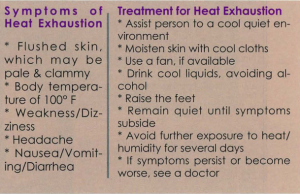 How to know when you are too hot
How to know when you are too hot
Heat exhaustion occurs when your heated body loses excessive amounts of body fluids and important salts. Heat exhaustion can really make you feel bad, but worse, if left untreated, it can lead to heat stroke which is a bona fide medical emergency. Just as you would take precautions against excessive numbers of stings, take precautions against high heat. Always have cool water or a cool drink nearby. Some beekeepers drink something like Gatorade® diluted fifty percent with water. Beekeeping can be hard work. Don’t make it worse by getting too hot.
Get professional medical assistance
The bit of information provided here is for general background knowledge only. If you are hot and working in a bee suit and feel strange and sickly, take measures to deal with the heat. Professional help and professional information are the best pathways.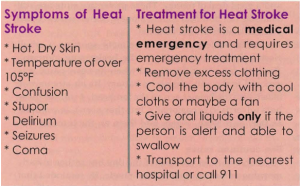
If this article sounds dire
Some of the points in this piece have a bit of a doomsday tone. For most of us, nearly all the time, beekeeping is enjoyable. It’s those rare occasions when a bee task must be done. Most of us work alone. It happens. We get in a hurry. The hives and hive supers are heavy. We become tired and hot. Be cool, take a break and for a while, come out of those heavy clothes. Take care of yourself and the bees.






